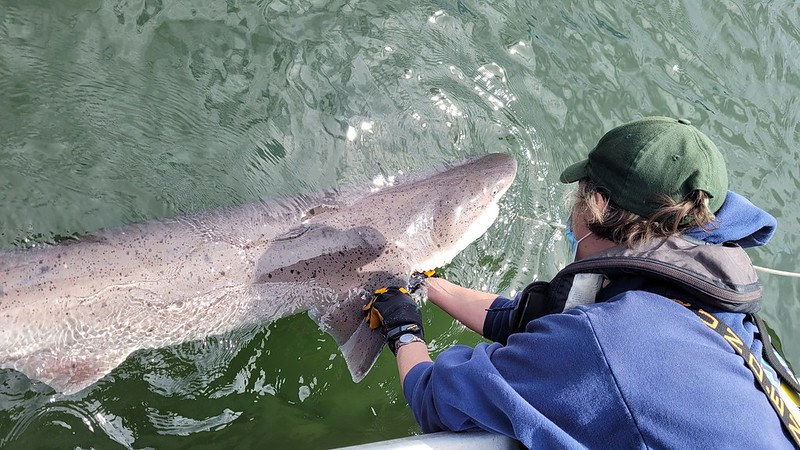Two shark species documented in Puget Sound for the first time by OSU researchers

CORVALLIS, Ore. (KTVZ) – Oregon State University researchers have made the first scientific confirmation in Puget Sound of two distinct shark species, one of them critically endangered.
The presence of the broadnose sevengill shark and endangered soupfin shark in the sound, the southern portion of the Salish Sea, may indicate changes in what biologists in OSU’s Big Fish Lab describe as an economically, culturally and ecologically valuable inland waterway.
The Salish Sea separates northwest Washington from British Columbia’s Vancouver Island. The 6,500-square-mile body of water stretches into Washington as Puget Sound, and the sharks were caught close to Olympia near the sound’s southernmost point.
Taylor Chapple, an assistant professor in Oregon State’s College of Agricultural Sciences, and graduate students Jessica Schulte and Ethan Personius report the broadnose sevengill and soupfin documentations in papers published in Frontiers in Marine Science.
The authors collaborated with partners at NOAA’s National Marine Fisheries Service and the Washington Department of Fish and Wildlife to confirm that the broadnose sevengill, an apex predator that can grow to nearly 10 feet, is now inhabiting heavily urbanized South Puget Sound.
“Understanding the sevengill presence in this new habitat is crucial for understanding the food webs of the Salish Sea, and it highlights the need for continued monitoring and research – including their relationship with other species of conservation concern, such as salmon,” said Schulte, the lead author on the sevengill paper.
Broadnose sevengill sharks – so named because they have two more gill slits than most shark species – eat a wide variety of prey: fishes (including rays and other sharks), crustaceans and marine mammals. They live in temperate waters worldwide, and off the West Coast of North America they range from southern Alaska to Baja California.
Prior to 2021, only one sevengill shark had ever been confirmed in the Salish Sea, at Point Roberts, Washington, near the Canadian border. In August 2021, however, anecdotal reports indicated several of them had been caught in South Puget Sound.
During 10 days of field work in 2022 and 2023, the scientists caught nine sevengills, more than 190 miles away from their previously documented range. Eight of them were males – the largest measured just under 7 feet – and the female was about 4 feet, 6 inches.
“Our continued research on this species in Oregon and Washington waters will allow us to have a better handle on its role in our valuable marine ecosystems,” Schulte said.
The same holds for the soupfin shark, said Personius, the lead author on that paper. It is the largest species of hound shark, can be as big as 6 1/2 feet and got its name because of its use as the key ingredient in shark fin soup.
“Soupfin sharks were relentlessly exploited during the 1930s and 1940s, including for their livers, which are rich in vitamin A,” Personius said. “Despite lower fishing pressure the species has not been able to recover and is currently under consideration for federal protection under the Endangered Species Act.”
Like the broadnose sevengill shark, the soupfin shark is found in temperate waters around the globe and is a top predator in any ecosystem it inhabits, eating cephalopods as well as a variety of fishes. Soupfin sharks are known as strong swimmers whose migrations can exceed 1,000 miles.
In field work concurrent with the sevengill project, the scientists caught one soupfin shark, a male that measured just over 5 feet.
“The Salish Sea has experienced pervasive shifts in species abundance and composition along with industrialization and significant habitat degradation,” Personius said. “The appearance of soupfin sharks may be a result of climate change and changes in prey availability.”
Following the 2014-15 extreme marine heat wave event known as “The Blob,” he explained, anchovies emerged as a dominant forage fish species in the Salish Sea after having been historically uncommon there. Soupfin sharks are a known predator of anchovies.
Graduate student Maddie English is a co-author of the soupfin shark paper, along with Dayv Lowery of the NOAA Marine Fisheries Service and Lisa Hillier of the Washington Department of Fish and Wildlife. Research associate Alexandra McInturf contributed to the sevengill study.